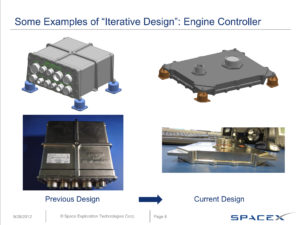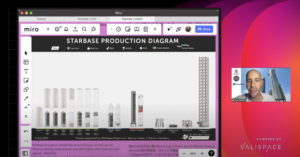
Valispace recently spoke to Michael Jastram and Joe Justice, both experienced system engineers, to take us into the inner workings of SpaceX and explore how they became the most important space engineering company on this planet (and beyond!).
They break down the company’s innovative approach to systems engineering, including data-driven design and the important role of modularity.
To explore all things systems engineering visit Jastram’s website Systems Engineering Trends and watch the Joe Justice complete video on our YouTube channel.
SpaceX, the pioneer of the private space industry, has transformed aerospace engineering through its innovative use of data-driven design and efficient organizational structure. The business’ novel strategy has modernized the sector and raised the bar for effectiveness and efficiency.
The company has been hot news in the press: successfully completing the first manned space flight for the US since 2011, when the Dragon capsule brought two astronauts safely back to earth on August the 2nd.
As systems engineers, we are curious about how SpaceX approaches systems engineering. Its success is largely attributed to its data-driven design approach. By using data and facts to guide decision-making, SpaceX is able to design and create complex aerospace systems with unprecedented efficiency.
Data is utilized to direct the development process from the original concept design through the final phases of system integration, reducing the risk of costly design errors and improving overall efficiency.
One of the key benefits of SpaceX’s data-driven approach is the ability to simulate and predict system performance under a range of conditions. SpaceX can spot possible problems early in the design phase thanks to these predictive capabilities and make the necessary revisions before building actual prototypes.
Introducing the AI era of systems engineering – Try it for yourself now
The philosophy of systems engineering at SpaceX
In the lecture “System Engineering: A Traditional Discipline in a Non-traditional Organization”, SpaceX explains how the culture of their organisation makes this possible.
SpaceX has a really interesting philosophy regarding product development. Whilst traditionally risk has been managed through excessive up-front analysis, SpaceX instead relies on rapid prototyping and iterative testing cycles. In the 21st century, we have the unique opportunity of being able to develop and test real systems in short development cycles.
At SpaceX rigorous testing is carried out at all levels – including on the completed rocket right before launch.
The organisation must be able to support this type of approach. Systems engineering thinking is therefore taught and put in practice at all levels and in all departments of SpaceX. All departments must also deal with integration and take a holistic point of view.
Its organizational structure plays a crucial role in its success. The company’s teams of engineers are organized in a way that promotes collaboration and communication, ensuring that everyone is working towards the same goals.
Information management and handling are crucial, and SpaceX has forgone traditional control boards and committees and is employing modern collaboration tools such as Jama and Valispace.
Valispace’s software platform provides a collaborative environment where engineers can manage and analyze data, simulate system performance, and make informed design decisions.
It provides a full view of the design process and seamless integration of data from various sources, including CAD tools, simulation software, spreadsheets, and other engineering tools.

Source: SpaceX – System Engineering: A Traditional Discipline in a Non-traditional Organization PDF
“Tools not Rules” – “Test rigorously and often”
The V-model at SpaceX
SpaceX does not operate and break down in a traditional fashion. Instead, key design parameters are identified and tracked all the way down to the design level. For example, a classic parameter is the weight of the rocket.
This approach allows much more flexibility at the design level. This is also the method used by the Valispace tool (German version).
The topic of integration and integration testing becomes even more important with this approach. Thus investing in an appropriate testing infrastructure is strategically important. SpaceX tries to make the tests as realistic as possible (“test as you fly”). This leads to many hardware-in-the-loop tests at the component level. Wherever possible the software is also included in the test.
SpaceX also runs many tests that intentionally lead to component failure. This allows failure scenarios to be examined more realistically. Of course, all relevant tests are carried out repeatedly with every change.
Whilst this approach does lead to a spectacularly high number of SpaceX explosions on YouTube, be reassured that most of these occurred during testing. Indeed, so far, only four satellite launches have failed, out of a total of 86 missions…
Modularity in SpaceX’s Design
A key aspect of SpaceX’s design philosophy is modularity. By designing components that can be used in multiple systems, SpaceX has been able to significantly reduce the time and cost associated with the design and development process.
This approach also allows for greater flexibility, as components can be easily replaced or upgraded as needed.

SpaceX’s Independent and Agile Teams
SpaceX’s engineering organization revolves around the concept of independent teams. Unlike traditional engineering companies with centralized management, SpaceX operates with self-organizing teams.
Joe Justice highlights that these teams work concurrently and independently, executing projects as fast as possible. The absence of centralized management structures allows engineers to take ownership and drive innovation, fostering a culture of trust and empowerment.
This fast paced environment starts from the moment of the onboarding, when a new employee joins the company – take a look at Joe Justice’s talk (Spoiler alert: it lasts only 4 hours!)
Trust in Engineers and Removal of Politics
SpaceX places great trust in its engineers, empowering them to tackle problems directly. Joe Justice emphasizes that SpaceX does not have traditional roles such as product managers, project managers, or architects.
Instead, engineers are entrusted with making decisions and finding solutions. By removing unnecessary bureaucracy and politics, SpaceX cultivates an environment where engineers can focus on their work, resulting in higher output, increased ownership, and a greater sense of purpose.
Replacing Management with Digital Self-Management
SpaceX, along with other companies under Elon Musk’s umbrella, aims to have an engineering-focused workforce by minimizing the layers of management.
Traditional engineering companies often have hierarchical structures, but Musk’s companies have replaced them with artificial intelligence (AI) software stacks. These software stacks provide real-time answers and guidance, enabling autonomous decision-making and self-management within the organization.
To the Moon! (or Mars!)
The aerospace industry has been completely transformed by SpaceX’s revolutionary use of data-driven design and modularity, as well as its efficient organizational structure.
The company’s strategy serves as a strong example for other businesses, showcasing how data-driven design can boost productivity, lower risk, and spur innovation.
